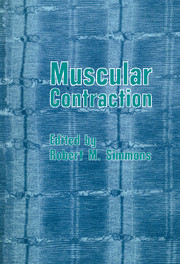Book contents
- Frontmatter
- Contents
- Dedication
- Contributors
- Preface
- 1 A. F. Huxley: an essay on his personality and his work on nerve physiology
- 2 A. F. Huxley's research on muscle
- 3 Ultraslow, slow, intermediate, and fast inactivation of human sodium channels
- 4 The structure of the triad: local stimulation experiments then and now
- 5 The calcium-induced calcium release mechanism in skeletal muscle and its modification by drugs
- 6 Hypodynamic tension changes in the frog heart
- 7 Regulation of contractile proteins in heart muscle
- 8 Differential activation of myofibrils during fatigue in twitch skeletal muscle fibres of the frog
- 9 High-speed digital imaging microscopy of isolated muscle cells
- 10 Inotropic mechanism of myocardium
- 11 Regulation of muscle contraction: dual role of calcium and cross-bridges.
- 12 Fibre types in Xenopus muscle and their functional properties.
- 13 An electron microscopist's role in experiments on isolated muscle fibres.
- 14 Structural changes accompanying mechanical events in muscle contraction.
- 15 Mechano-chemistry of negatively strained cross-bridges in skeletal muscle.
- 16 Force response in steady lengthening of active single muscle fibres.
- References
- Index
7 - Regulation of contractile proteins in heart muscle
Published online by Cambridge University Press: 07 September 2010
- Frontmatter
- Contents
- Dedication
- Contributors
- Preface
- 1 A. F. Huxley: an essay on his personality and his work on nerve physiology
- 2 A. F. Huxley's research on muscle
- 3 Ultraslow, slow, intermediate, and fast inactivation of human sodium channels
- 4 The structure of the triad: local stimulation experiments then and now
- 5 The calcium-induced calcium release mechanism in skeletal muscle and its modification by drugs
- 6 Hypodynamic tension changes in the frog heart
- 7 Regulation of contractile proteins in heart muscle
- 8 Differential activation of myofibrils during fatigue in twitch skeletal muscle fibres of the frog
- 9 High-speed digital imaging microscopy of isolated muscle cells
- 10 Inotropic mechanism of myocardium
- 11 Regulation of muscle contraction: dual role of calcium and cross-bridges.
- 12 Fibre types in Xenopus muscle and their functional properties.
- 13 An electron microscopist's role in experiments on isolated muscle fibres.
- 14 Structural changes accompanying mechanical events in muscle contraction.
- 15 Mechano-chemistry of negatively strained cross-bridges in skeletal muscle.
- 16 Force response in steady lengthening of active single muscle fibres.
- References
- Index
Summary
Introduction
Although it is often difficult and generally dangerous to try to identify the best piece of work or the most influential observation or the seminal result in a field of research, it is tempting to do so on this occasion. In order to make the task easier, I would prefer to list not one but a small group of contributions to the field of muscle biology, each devoted to a different aspect of the biology of the muscle cell. Few would question that A. V. Hill's (1938) paper on the energetics of muscle contraction belongs to this group of distinguished papers, and the separate but interrelated efforts of Ebashi and Weber to show that calcium ions were the activators of the contractile system have been equally important (Weber & Winicur, 1961; Ebashi, Ebashi, & Kodama, 1967). The introduction of electron microscopy to the study of muscle ultrastructure by H. E. Huxley in 1957 demonstrated the existence of two sets of interdigitating filaments and provided the ultrastructural basis for the basic mechanism of contraction. The remaining three developments that belong to this brief list of milestones to the understanding of muscle function were contributions of A. F. Huxley: (1) the constancy of the width of the Abands over a wide range of lengths of striated muscle (A. F. Huxley & Niedergerke, 1954, 1958), (2) the local activation of a very limited portion of a single muscle fibre by the localized depolarisation of the surface membrane (A. F. Huxley & Taylor, 1955b, 1958), and (3) the first comprehensive and quantitative theoretical model for the mechanism of contraction based on the existence of a large population of force generators (A. F. Huxley, 1957a).
- Type
- Chapter
- Information
- Muscular Contraction , pp. 107 - 116Publisher: Cambridge University PressPrint publication year: 1992



